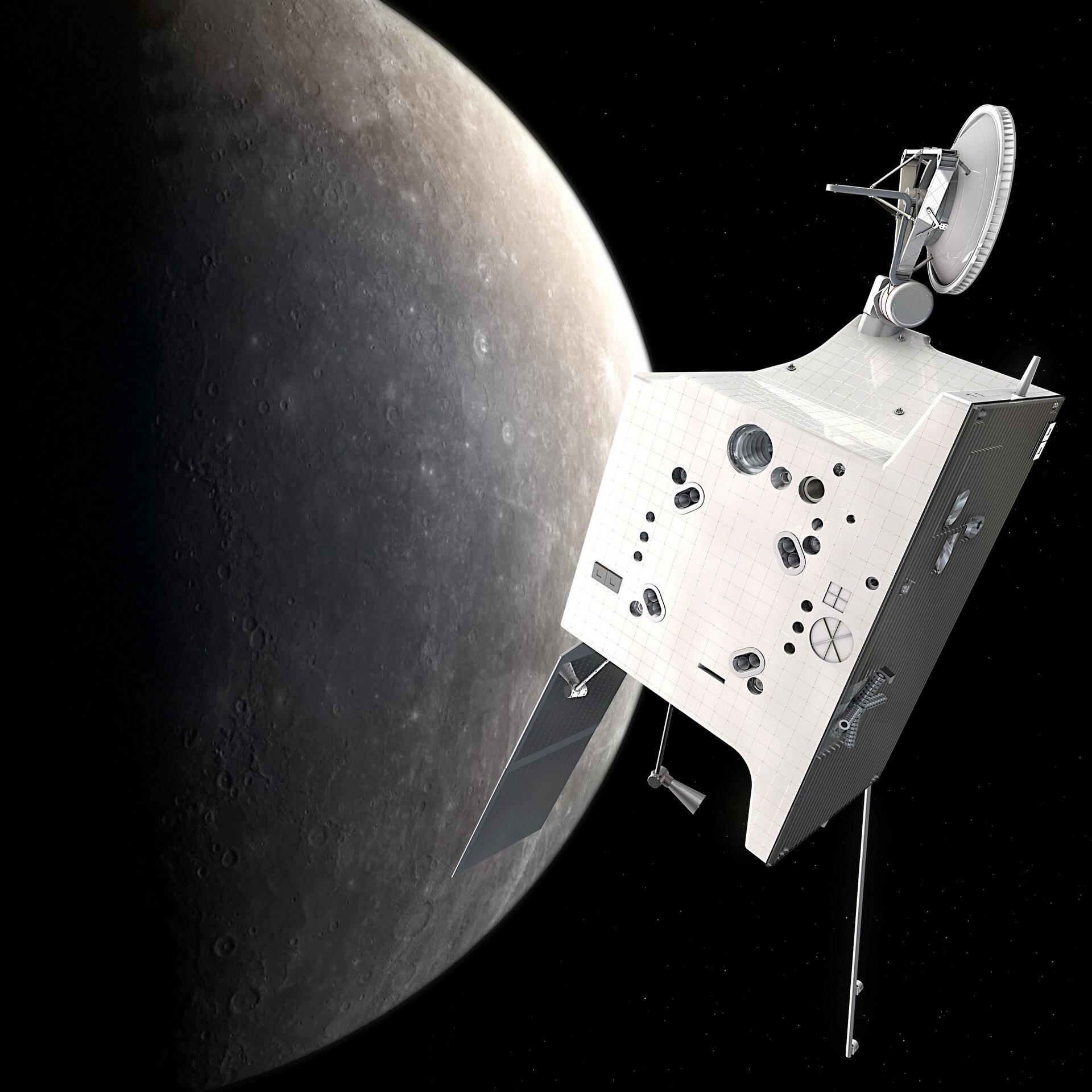2/24 ESA's BepiColombo Mission - General Overview with a Special Focus on ESA's Mercury Planetary Orbiter | On Things to Come

BepiColombo was launched on 20 October 2018 the BepiColombo from the European spaceport in French Guyana and is now on route to Mercury to unveil Mercury’s secrets. BepiColombo with its state of the art and very comprehensive payload will perform measurements to increase our knowledge on the fundamental questions about Mercury’s evolution, composition, interior, magnetosphere, and exosphere. BepiColombo is a joint project between the European Space Agency (ESA) and the Japanese Aerospace Exploration Agency (JAXA) and consists of two orbiters, the Mercury Planetary Orbiter (MPO) and the Mercury Magnetospheric Orbiter (Mio).
The BepiColombo will perform nine planetary flybys during its 7-year long journey to the innermost terrestrial planet. During this cruise phase BepiColombo is in a so called “stacked” configuration where the two spacecraft are sitting on top of a transfer spacecraft. Only in late 2025, this configuration is abandoned and the individual elements spacecraft are brought in to their final Mercury orbit: 480x1500km for MPO, and 590x11640km for Mio. The mission has been named in honor of Giuseppe (Bepi) Colombo (1920–1984), who was a brilliant Italian mathematician, who made many significant contributions to planetary research and celestial mechanics.
On its way BepiColombo has several opportunities for scientific observations - during the cruise into the inner solar system and during nine flybys (one at Earth, two at Venus and six at Mercury). However, since the spacecraft is in a stacked configuration during the flybys only some of the instruments on both spacecraft will perform scientific observations.
A status of the mission and its instruments with special emphasis on the MPO (since further talks on Mio and dedicated instruments will follow in the weeks after) will be given.
About Johannes Benkhoff
| 23 September 2020 4 pm (GMT+8) |
Geraint Jones – ESA Comet Interceptor Mission [YouTube/Youku] |
| 21 October 2020 8 pm (GMT+8) |
Ralph Lorenz – NASA Dragonfly Mission [YouTube/Youku] |
| 4 November 2020 4 pm (GMT+8) |
Wang Chi – ESA SMILE Mission [YouTube/Youku] |
| 25 November 2020 4 pm (GMT+8) |
Heike Rauer – ESA PLATO Mission [YouTube/Youku] |
| 9 December 2020 4 pm (GMT+8) |
Takehiko Satoh – JAXA Akatsuki Mission [YouTube/Bilibili] |
| 18 December 2020 4 pm (GMT+8) |
Olivier Witasse – ESA JUICE Mission [YouTube/Bilibili] |
| 21 December 2020 4 pm (GMT+8) |
Tomohiro Usui – JAXA MMX Mission [YouTube/Bilibili] |
| 13 January 2021 4 pm (GMT+8) |
Weiqun Gan – CAS ASO-S Mission [YouTube/Bilibili] |
| 27 January 2021 4 pm (GMT+8) |
Giovanna Tinetti – ESA Ariel Mission [YouTube/Bilibili] |
| 24 February 2021 4 pm (GMT+8) |
Johannes Benkhoff – ESA BepiColombo Mission I Register |
| 10 March 2021 4 pm (GMT+8) |
Gabriele Cremonese – ESA BepiColombo Mission II Register |
| 24 March 2021 4 pm (GMT+8) |
Go Murakami – ESA BepiColombo Mission III |
| 7 April 2021 4 pm (GMT+8) |
Yoshifumi Saito – ESA BepiColombo Mission IV |
| 14 April 2021 4 pm (GMT+8) |
Daniel Mueller – ESA Solar Orbiter Mission I |
| 21 April 2021 4 pm (GMT+8) |
Stefano Vitale – ESA LISA Mission |
| 6 May 2021 10 am (GMT+8) |
Andy Cheng – The DART Mission |
| 19 May 2021 4 pm (GMT+8) |
Saem Krucker – ESA Solar Orbiter Mission II |
| 25 May 2021 4 pm (GMT+8) |
Sami Solanki – ESA Solar Orbiter Mission III |
| 2 June 2021 4 pm (GMT+8) |
Athena Coustenis – ESA HRE Program |
| 9 June 2021 4 pm (GMT+8) |
Yuan Weimin – CAS Einstein Probe Mission |
| 16 June 2021 10 am (GMT+8) |
Evgenya Shkolnik – NASA SPARCS Mission |
| 30 June 2021 4 pm (GMT+8) |
Ren Laurelijs – ESA EUCLID Mission |
| 1 July 2021 10 am (GMT+8) |
Lindy Elkins-Tanton – NASA Psyche Mission |
| 14 July 2021 4 pm (GMT+8) |
Tomoko Arai – JAXA DESTINY Mission |
